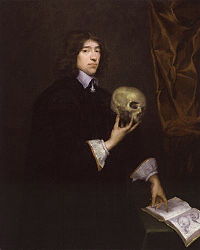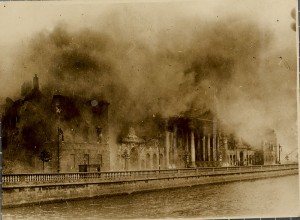In October 2013 I joined the team on the Early Modern Practitioners project as a relative newcomer to medical history. Since then I have enjoyed the opportunity to approach early modern Ireland from what is, for me, a new and rewarding direction.
In my previous research, encompassing landownership, politics, religion and various other subjects, I had frequently come across medical practitioners. For example, at least four Catholic physicians were among those who received assignments of land in the transplantation to Connacht, the scheme that was the focus of my doctoral thesis. Another physician, William Petty, played a fundamental role in the implementation of the Cromwellian land settlement.
While figures such as Petty need no introduction, the vast majority of medical practitioners enjoyed far less contemporary prominence. The evidence that has survived concerning this majority varies greatly in content and extent. Still, there can be few, if any, historians of early modern Ireland who have not encountered a medical practitioner of one kind or another at some point in the course of archival research.
When addressing the issue of archival resources for the history early modern Ireland, it is always tempting to focus on gaps and absences. After all, a few well-known disasters have served to deprive scholars of an enormous body of source materials. In a western European context, the Irish archive can appear meagre in some respects, especially when compared to England.
Within the Early Modern Practitioners project, the evidence available from wills provides one of the more striking contrasts between Ireland and England. All but a handful of Ireland’s surviving prerogative and diocesan wills were destroyed in 1922, and many of the surviving indexes lack occupational data. Identifying and analysing what has survived in miscellaneous copies and genealogical abstracts is a challenging task, but also a very worthwhile one. Among the more useful resources is the collection of transcripts of medical wills made by Sybil Kirkpatrick in the Public Record Office in 1910-11 and now housed in the Royal College of Physicians of Ireland.
The problem of gaps and absences is not simply due to the subsequent destruction of archives. It is also worth keeping in mind that the administrative and corporate structures that generated some important sources for medical history in other early modern states were sometimes lacking or ineffective in Ireland. For example, ecclesiastical licensing of medical practitioners does not seem to have been widespread. This is, however, a subject that requires further exploration. The relative weakness of the Church of Ireland and the fact that most of the population adhered to Catholicism was undoubtedly of importance in this context.
This very brief recital of some of the limitations imposed by the available sources is not intended as an exercise in pessimism. It is helpful, I think, to go about establishing where the existing boundaries are and where they might usefully be pushed back. Drawing contrasts with the richer source bases often available for other countries and regions is part of the task of locating and making sense of the medical history of early modern Ireland in wider contexts. There is plenty of work to be done and much to be optimistic about. Stay tuned.



Pingback: Whewell’s Gazette: Vol. #22 | Whewell's Ghost
I’m only researching one doctor — a possible ancestor named Magnus Prince, who seems to have practiced in counties Down and/or Antrim around the years 1700 – 1745 — but I’m encountering the same difficulties as far as lack of resources. He’s been referred to as a “Doctor of Physick” and was likely born in Scotland, so I hope to find some information about him there. I’m eager to see what information you can come up with for that area, in the course of your extensive research. Apparently he corresponded with Sir Hans Sloane and advocated the practice of inoculation as early as the 1720s, so I hope to find some documentation soon. It would be interesting to see whether he was able to affect the infectious disease rates of the area over the course of his career.
Dear Valerie,
Thanks for your query. I have not come across Marcus Prince before. If you would like to share your findings on him with us, he certainly appears to merit inclusion in our database.
I have just checked Richard Clarke’s extensive Directory of Ulster Doctors (who qualified before 1901) (2 vols., Belfast, 2013). Unfortunately there is no entry for Prince here. Also worth looking up is Robert Whan’s book The Presbyterians of Ulster, 1680-1730 (Woodbridge, 2013), which is another very rich source of information for the period in question.
You will find evidence of Prince’s correspondence with Sloane in the Sloane correspondence in the British Library. This source is becoming increasingly available online at https://drc.usask.ca/projects/sloaneletters/doku.php and a quick search shows a reference to a 1729 letter from Prince in BL, Sloane MS 4,050.
Vicars’s Index to Prerogative Wills does not contain a reference to Marcus Prince. It does however show a Charles Prince, of Berkshire origin, in Tipperary as early as 1686. In relation to wills, it would be worth checking the Down & Connor diocesan will indexes, which are available in the NAI and PRONI.
Thanks so much for your response. I’ve asked a friend to visit the British Library archives to view and hopefully transcribe those six or seven letters exchanged between Dr. Magnus Prince and Sir Hans Sloane. The letter you reference, which is now online, is not yet transcribed but is summarized thusly:
“Prince waited to reply to Sloane’s letter so he could send something of interest. He has included a ‘litle box with blew earth’ and comments on each specimen. Prince did not take stock of the age or symptoms of those who had been inoculated in Belfast. He suggests that most were between five and fourteen years of age and all had survived. Prince then recounts, in detail, an episode in which he ‘directed the inoculation of 4 children of a gentleman in the County of Derry’.”
Source page: https://drc.usask.ca/projects/sloaneletters/doku.php?id=letter&letterid=3942
So it seems we are on to something! I do know that one letter mentions the doctor’s nephew, a sailor with the East India Company. Hopefully it contains the nephew’s name. Dr. Prince is also mentioned in a book called Six Famous Sons of Killyleagh by Clive Scoular, in the section on Sir Hans Sloane. The sources for this section are likely the letters held by the British Library, as the book mentions that Dr. Prince medically treats some relatives of Sir Sloane’s and they discuss inoculation. I don’t yet know where Dr. Magnus attended medical school, but he is not in any of the Irish or Royal Physicians colleges’ rolls. I’m still checking the Edinburgh and Glasgow university archives.
Dr. Prince was apparently the son or nephew of Sir Magnus Prince, Lord Provost of Edinburgh from 1687 – 1689. Sir Magnus went to London in 1688 to formally congratulate the king on the birth of his son and apparent heir, James Francis Edward Stuart. When William of Orange invaded in the winter of that year, Sir Magnus made his support of King James II very public (the king had supported him for the post of Lord Provost), which may have been a bad idea, in retrospect. Sir Magnus was “deposed”, to use the language I’ve read in other sources, and died within the next year or two, in his mid-forties. I’m still trying to find out the circumstances of these vaguely-described events or even a portrait of him, but I do know that he is interred in Greyfriars Kirkyard in Edinburgh with many other Lords Provost. I’ll be visiting him in June.
PRONI does have a will index record for Dr. Magnus Prince from 1746, County Down, but the document itself and its transcription appear to have been lost or destroyed. The only record that remains is the name, year, location, and type of document it was.
I also checked Directory of Ulster Doctors (who qualified before 1901) and found nothing (rather, I contacted the Ulster Historical Foundation to ask if they would check it, and they responded). Dr. Prince does show up in several records in the Registry of Deeds, which is unfortunately not yet searchable online. I will be in Dublin in May and am planning to search the full registry at that time. The few indexed records I’ve found so far, along with the titles of Dr. Magnus’s letters to Sir Hans Sloane, have helped me track the doctor’s whereabouts throughout Down. I believe he died in Downpatrick.
You are certainly welcome to email me about Dr. Magnus Prince, if you’d like further information. Hopefully I will have more this summer. As it seems that both Dr. Magnus and Sir Magnus have been all but lost to history, it would bring me a great sense of accomplishment for the doctor to be included in your database. Thank you again for your time.